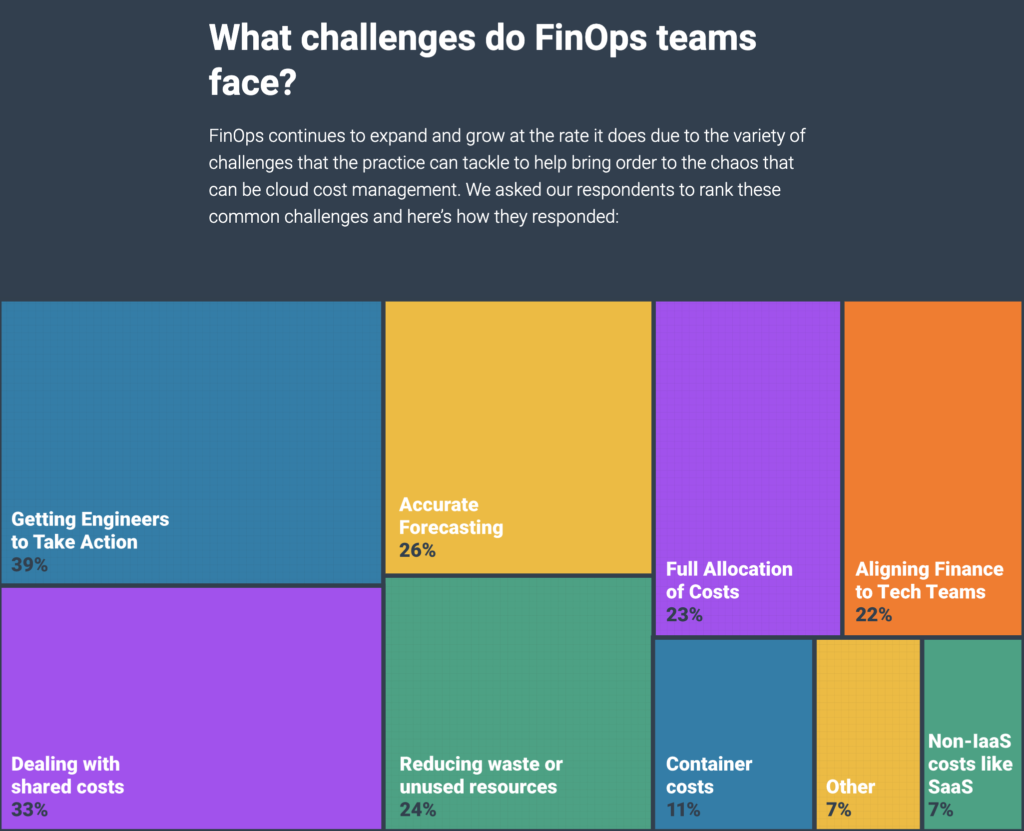The FinOps Foundation recently released the results of a wide-scale survey of Cloud Cost practitioners around the world. If you’re reading this blog and aren’t already a member, highly recommend joining the group to benefit from a broad array of perspectives, and connect with folks who may have experience solving the problems you face.
One of the key findings from the survey – the biggest challenges surrounded “Getting Engineers to Take Action”:

In this blog’s previous entry an approach for dealing with this challenge was described. While there’s a lot of actionable content there, given the prevalence of this as a pain point in the FinOps community, I thought it might make sense to zoom out and look at how to shift perspective and quickly soothe some pain amongst my peers.
Now, it would be the rare case where we as FinOps personnel are positioned organizationally to compel engineers to prioritize cost-saving measures above their competing pressures to grow/innovate, secure, and stabilize their services. This comes back to the four competing priorities engineering groups face, mentioned in the blog’s first post:

It’s human nature to believe what one toils away at all day long is critical to the organization, but an important truth to consider is that sometimes what we’re doing – while still of huge value and importance – may not be the most important thing to the organization, in that moment. If we are responsible for cost optimization but don’t see engineers actively performing cost-saving work, does that mean we’re failing at our jobs? If so what should we do about it?
My suggestion is to not judge your success in cost optimization by the completeness of every conceivable cost-opt checklist. Instead, measure it as the organization’s knowledge and comfort of its position on efficiency – its attainment of a self-aware equilibrium of efficiency against competing business forces.
Engineering inaction in cost optimization is not necessarily a failure of the cost opt function. If the cost opt team has surfaced the universe of cost-saving opportunities, attributed them to the right dev teams, quantified them using metrics allowing for apples-to-apples comparison against competing priorities, provided concise assisted pathways to remediation, and presented a business case to engineering leadership for action – then the team is doing its job.
If there’s inaction, but engineering teams have only been given vague guidelines (“have you tried turning stuff off at night?”), no harvesting or quantification of their opportunity set has been performed so they can’t enumerate and prioritize their choices, and no guidance or help exists on how to fix things – then the cost opt team needs to look inward, as it still has work to do.
Engineering leadership is constantly adjusting the balance between the above four domains based on business climate and direction. A healthy balance exists when there’s a continuous evaluation of opportunities with action taken only on those offering suitably high ROI. In some quarters, you should expect cost opt to get little to no attention; the flip side is in quarters where the budget is tight you may find huge appetite to attack cost saving opps.
You can be certain the Security, Operations, and Product Management engineering-please-do lists are never complete, we shouldn’t expect the Cost Opt one to be there either. In fact, I’d worry about the prospects of a company choosing to fully prioritize today’s million-dollar cost savings opportunity over tomorrow’s billion-dollar blockbuster.
An alternative title to this post could be, “How to Sleep at Night as a FinOps Practitioner, Knowing Your Org is Wasting Megabucks in the Cloud” 😉
